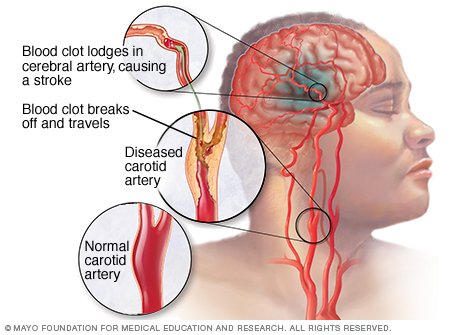Understanding Stroke
Stroke is a condition that occurs when blood supply to the brain is cut off due to blockage or rupture of blood vessels, resulting in the death of cells in some areas of the brain. Stroke is a serious health condition that requires rapid treatment.

When the supply of blood carrying oxygen and nutrients to the brain is severed, the brain cells begin to die. Because of the faster the patient is handled, the damage is even smaller and even death can be avoided. If you feel a stroke or seeing another person having a stroke, contact the hospital immediately for an ambulance.People whose age is more than 65 years most at risk of stroke. However, twenty-five percent of strokes occur in people younger than 65, including children.
People who smoke, lack of exercise, and have a poor diet are also prone to stoke. In addition people whose blood circulation is disrupted due to high blood pressure, high cholesterol, irregular heartbeat or atrial fibrillation, and diabetes, are also more prone to stroke.
What is STROKE ???
Stroke can be a major disabling incident. It affects annually over 15 million people worldwide. It can leave people unable to walk, talk and usually affects one side of the body, causing impaired movement and often paralysis. So what exactly is a stroke? A stroke occurs when the blood supply to the brain is interrupted or severely reduced, depriving the brain tissue of oxygen and nutrients. Within minutes, brain cells begin to die.

(source: www.mayoclinic.org)
There are two main causes of stroke: a leaking or burst blood vessel, or blocked artery (blood clot). Once you have been identified treatment can begin. The first step is to rule out the causes of symptoms, such as a brain tumor or a reaction to drugs. After carrying out tests and identifying the type of stroke, treatment will focus either on stopping the bleeding or dissipating the blood clot; most times this causing the stroke has been stabilized, the main focus is on improving strength and function. The brain is a remarkable organ and is capable of recovery and regeneration, and the sooner the process begins, the greater chance of recovery. Rehabilitation is a major part of treatment. Recovery largely depends on the part of the brain affected, how quickly treatment was received and the extent of the damage to the brain. In some cases the recovery will never be as it was before but the aim is to improve the function and regain independence.
What are the symptoms?
Problems with speaking and understanding, vision, balance, coordination and swallowing. You may experience confusion. You may slur your words or have difficulty understanding speech; paralysis, numbness or weakness of the face, arm or leg. This is usually on one side of the body but can affect both. Headache, dizziness and unsteadiness.
What Are The Risk Factors?
As noted earlier, strokes can be caused by a stroke (and a heart attack). So by modifying your lifestyle and certain behaviours you can reduce your risk:
Smoking: Smoking or exposure to second-hand smoke can increase your risk; the chemicals found in tobacco can damage your arteries.
High blood pressure: Check your blood pressure at least once a year, as most often there are no symptoms. If your blood pressure is prescribing medication to prevent damage to the arteries.
Being Overweight: Being overweight can increase your blood pressure, which is a leading cause of stroke. It can also put you at risk of developing stroke, such as high cholesterol, high blood sugar, and heart disease.
High cholesterol: Again, have your cholesterol checked regularly. If detected, this can be treated either by changes to your diet or medication.
Diabetes: If you have diabetes it is important to follow healthy diet levels as close to normal as possible.
Alcohol: Monitoring your alcohol intake is important. You should drink no more than 14 units a week and should be spread throughout the week, at least two days every week where you do not have any alcohol at all.
How to Recover from a stroke
It is important to start your recovery and compensation techniques. Regaining strength and balance are the first steps to get back on your feet. Getting up and out of bed every day should be a priority and guidance from a physiotherapist can help you achieve your goals. Not everyone will achieve a full recovery but learning how to reduce the burden on family and friends.
 (source: cdn1-a.production.images.static6.com)
(source: cdn1-a.production.images.static6.com)
Physiotherapy rehabilitation programmes often focus on:
• Activities of daily living such as bathing, dressing and eating
• Mobility skills, transferring between bed and chair / wheelchair, walking, wheelchair skills.
Despite taking measures to reduce the risk of suffering a stroke, it is a disease that can even affect the healthiest of people. All we can do is reduce our risks and ensure that the worst should happen, our bodies are strong and
healthy enough to make the road to recovery an easier battle.

A few articles that I can share, may be useful. if there is a writing error or the name of the source apologize.
Source:
 https://stluciastar.com/what-is-a-stroke
http://www.alodokter.com/stroke
https://stluciastar.com/what-is-a-stroke
http://www.alodokter.com/stroke
good, by cindy.
Good article @febby
Congratulations @febby! You have received a personal award!
Click on the badge to view your Board of Honor.
Do not miss the last post from @steemitboard:
Congratulations @febby! You received a personal award!
You can view your badges on your Steem Board and compare to others on the Steem Ranking
Vote for @Steemitboard as a witness to get one more award and increased upvotes!